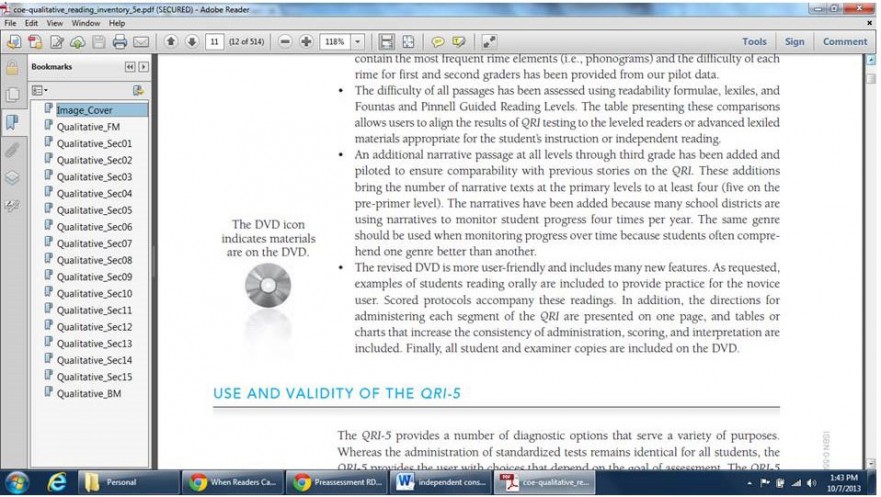This is a bit of a rant.
It ends with: I am currently learning to administer reading assessments and plan instruction in targeted reading intervention with a digital textbook that I cannot annotate, bookmark, sticky-note, or otherwise violate at my will. I must sign into my textbook each time I use it. I imagine that, after the course is done, I will not even have access to it, though I have not verified this.
I am taking a graduate level reading practicum course required for me to add Grade 6-12 Reading to my Arizona license. The main text is the Qualitative Reading Inventory, 5th Edition, by Leslie and Caldwell. This book is currently $57.19 on Amazon. If I ordered it there, I could write in it, sticky-note it, highlight it, bookmark it, or beat my head against it when I needed to. I could do all the things to that book that I teach readers to do with any text. I could do all the things to that book that developmental reading teachers at the community college level have been teaching struggling adult readers to do with textbooks in order to become better readers.
But I can’t do any of those things with my digital course text.
Grand Canyon University required me to pay $105.00 as a textbook fee to access the text online. This is not an unusual fee whether you take courses there or online courses through other schools. At first I thought, that’s pretty cool. Then I can read it wherever I need to without hauling the book around.
Then, I found I had to log into the e-text each time. That was slightly annoying, but no big deal. However, when I tried to put it on my Kindle software or save it in Google Drive, that didn’t work. The document password protection did not translate into those formats and I couldn’t see anything.
Once I began to read the parts of the textbook that related to specific assessment procedures I would be implementing in a day or two, I began highlighting things. When I logged back in, the highlights were gone. The same thing happened with comments.
I also wanted to bookmark pages, but could not add bookmarks beyond the ones at the beginning of each chapter. To make things more frustrating, the chapter numbers were on the permanent bookmarks, not the titles. I could not figure out where I was in the book without scanning down through individual pages.
The book is 518 pages long. Approximately 200-300 of those pages are individual passages and word lists to be used with students. It’s hard to explain how impatient I began to get scrolling back and forth through those pages trying to locate what I needed. In a paper textbook, I could have used post-it tabs or tiny shredded bits of paper to mark those pages. I could have binder-clipped them together. I could flip through them visually in seconds instead of waiting for each to load. So simple. So much less expensive.
When I think about how this policy relates to my teaching practice, two things occur to me:
a. Are we not representing the world of reading accurately when we teach students that texts are immediately interactive, that they should be doing close reading and annotation, they should write all over the text and own it. They should make it theirs. Will their texts be theirs? Really? Will they have these comprehension tools in their post-secondary lives? I am not sure.
b. If this is the type of reading experience we are to prepare them for, does it change what we need to be doing with texts in the classroom? How? I feel ill-equipped to deal with this 500+ page monstrosity before me, although I know I need to learn both the broad strokes and the nuances of what is in it. I am feeling waves of anxiety over the next four weeks even as I speak.
To be honest, neither a. nor b. disturbs me as much as the anxiety and frustration I am feeling right now as I try to navigate this new material. I am angry and resentful about this aspect of my learning experience. And then when I consider my high school sophomores who are reading at an elementary reading level currently, and the likelihood that they would successfully complete a course with this kind of textbook, I resent it even more.
I have called tech support, and sure enough, there is nothing they can do about it at this time. It is not in their control because it is supposedly an issue with Adobe Reader (which the university chose to use). It is something they are “working on.” Do other students complain? I ask. “It has been an issue in the past from time to time.” Could I have refused to pay the textbook fee and chosen to order the text? “No. It’s just included as part of your course fees.” Can you tell me who I should write an angry letter to? The reading department head? Who? “Like I said, it’s just something that is inherent in the e-text format.” Really?








